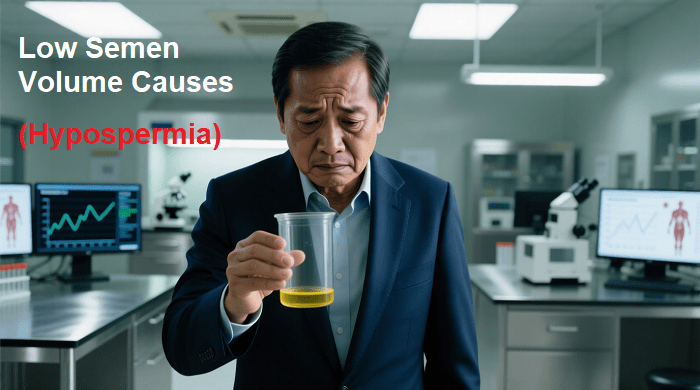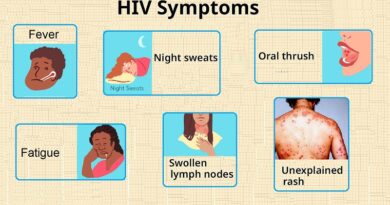Medical Causes of Low Semen Volume (Hypospermia)
Last Updated on 11/17/2025 by Helal Medical
Low semen volume is often a sign of an underlying issue. This issue affects the transport or production of the seminal fluid. The seminal fluid is mainly produced by the seminal vesicles and the prostate gland.
1. Retrograde Ejaculation
- What it is: You have semen but not going out from the penis during ejaculation. Instead, it is directed backward into the bladder during orgasm.
- Underlying Issues:
- Functional: Damage or dysfunction of the internal bladder sphincter, often due to:
- Certain medications (e.g., alpha-blockers used for high blood pressure or enlarged prostate).
- Health conditions like diabetes (due to nerve damage/neuropathy).
- Structural: Surgical procedures on the bladder neck or prostate.
- Functional: Damage or dysfunction of the internal bladder sphincter, often due to:
2. Ejaculatory Duct Obstruction (EDO)
- What it is:
It’s a blockage in the tubes known as ejaculatory ducts. These ducts carry semen from the seminal vesicles and vas deferens to the urethra. - Cause of Low Volume:
The secretions from the seminal vesicles contribute the majority of the fluid volume. They are blocked from mixing with the rest of the semen. You have sperm but no fluid! - Underlying Issues:
- Congenital cysts.
- Scarring from infections (e.g., chlamydia, gonorrhea) or inflammation.
- Calcification or stones in the seminal vesicles.
3. Issues with Seminal Vesicle or Prostate Functions
- What it is:
The seminal vesicles produce the largest part of semen volume (around 70%). The prostate contributes about 20%. - Cause of Low Volume:
If these glands are underdeveloped, damaged, or not functioning correctly, semen volume will be significantly low. - Underlying Issues:
- Congenital Bilateral Absence of the Vas Deferens (CBAVD):
It is often associated with mutations in the Cystic Fibrosis (CF) gene. These mutations can also affect the development of the seminal vesicles. - Severe Androgen (Testosterone) Deficiency:
Low hormone levels can lead to decreased seminal vesicle and prostate secretions.
- Congenital Bilateral Absence of the Vas Deferens (CBAVD):
4. Severe Hormonal Imbalance (Hypogonadism)
- This is a situation of extreme low levels of testosterone or other hormones. It includes Follicle-Stimulating Hormone (FSH) or Luteinizing Hormone (LH). These hormones are needed for healthy reproductive system.
- Cause of Low Volume:
Hormones regulate the function of the seminal vesicles and prostate. Low levels lead to decreased fluid and sperm production.
🔬 Diagnostic Methods for Low Semen Volume
The primary tool for investigating reproductive health, including seminal volume, is the Semen Analysis. If the volume is low, further tests are required to find the underlying cause.
1. Semen Analysis (The Essential First Step)
- It’s a laboratory test to measure volume, sperm count, motility, and morphology.
- It confirms that the volume is consistently below the WHO lower reference limit of 1.4\ mL.
2. Post-Ejaculation Urinalysis
- It is the definitive test to diagnose Retrograde Ejaculation.
- Urine is collected and analyzed after ejaculation.
- Key Finding: There is a significant amount of sperm in the urine. This confirms that the semen traveled backward into the bladder.
3. Imaging Studies
- Transrectal Ultrasound (TRUS):
- A probe is inserted into the rectum to view the prostate, seminal vesicles, and ejaculatory ducts
- To look for signs of Ejaculatory Duct Obstruction (EDO). These signs include dilated (enlarged) seminal vesicles. Cysts near the ejaculatory ducts can be found.
- Scrotal Ultrasound:
- To assess the testicles and epididymis for any structural abnormalities. This assessment focuses more on sperm production issues, like varicoceles.
4. Hormone Testing (Blood Tests)
- To check for underlying hormonal imbalances.
- Tests include measurements of:
- Testosterone (Total and Free).
- FSH (Follicle-Stimulating Hormone) and LH (Luteinizing Hormone).
- Prolactin.
5. Genetic Testing
- To rule out genetic conditions, especially when semen volume is low and sperm is absent or severely low.
- Key Tests:
- Testing for the Cystic Fibrosis (CF) gene mutations, which are strongly linked to seminal vesicle issues.
- Karyotyping to check for chromosomal abnormalities (e.g., Klinefelter syndrome).
A specialist doctor will use these tests to decide the precise cause. Based on this, the most effective treatment plan will be recommended. The plan ranges from medication to surgery.
Summary
Low semen volume is often caused by Retrograde Ejaculation. This condition means semen enters the bladder. Another cause is Ejaculatory Duct Obstruction, where a blockage prevents fluid mixing. Hormonal Imbalances also contribute, as low testosterone affects gland functions. Infections and congenital issues like CBAVD are also key factors.
Sources
- NIH: Steps in the investigation and management of low semen volume in the infertile man
- Urology Care Foundation: Male Infertility: Symptoms, Diagnosis & Treatment
Discover more from Helal Medical Manila
Subscribe to get the latest posts sent to your email.




